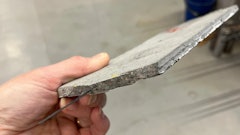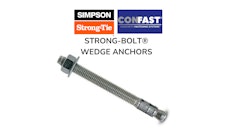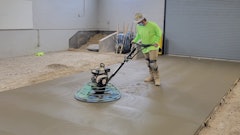
Question: Recently, one of our builder client’s home owners requested that no chloride be added to the concrete for the winter walls. Our state design code required vertical structural steel reinforcement for the foundation condition and there was no specification in the contract documents preventing the use of a chloride-based admixture. However, as requested, we did not use any CaCl2 on this project, although we do frequently in the months dominated by sub-freezing temperatures. The ready mix producer has also verified that no CaCl2 was added at the plant or the jobsite by their employees. Despite our assurances, the home owner privately contracted for the wall to be tested by a laboratory. This test came back conclusive of chloride ions in the wall, prompting them to stop the builder from continuing until this gets resolved. We need to know what the restrictions are as well as the possible sources for this issue to advise the builder, satisfy the home owner and continue this work – Foundation Contractor (Ohio).
Answer: The problem created here is due to the overabundance of information regarding the effects of chloride on steel reinforcement and the numerous resources that one might turn to for advice. The home owner, while savvy enough to check on this information and place a request on the project to protect any sort of problem that might occur, did not do enough work to ensure an understanding of the code requirements and the physical reality of this condition. Let’s take a look at some of the key issues and factors.
Both ACI 318 and ACI 332 address the durability of the concrete related to chloride with a process of assigning an exposure category and placing limits on the maximum chloride content based on the particular category. At the time this inquiry is being fielded, the two codes match in their limits and their direction.
First, an exposure category must be selected. Using ACI 332, since this is a residential foundation application, see the relevant portion of Table 5.2.1.
The exposure categories are intended for the application of consideration for concrete members with reinforcing steel intended for the resistance of loads, in other words, structurally reinforced concrete. Were these walls to be designed and built as plain, structural or walls without vertical steel or vertical steel used only to space horizontal bars, they would automatically be given a category selection of RC0. However, as described in this particular project application, the walls did contain vertical steel so further consideration of the exposure category and possible chloride limits is valid.
Vertical concrete foundation walls (for basements) are of a unique exposure to consider. It is most likely not appropriate to assign a category exposure of RC2 since they are vertical and therefore do not have deicing salts or other direct contacts with external sources of chloride. The assessment of RC0 or RC1 becomes the primary focus. The interior is considered dry and protected assuming the basement is living space and not a crawl space wall or carrying any other odd exposure. The exterior of concrete foundations are sometimes left unprotected, sometimes coated with a bituminous damp-proofing and when required or desired finished with a true waterproofing membrane. If the waterproofing membrane is provided, it is installed from the vertical footing surface (below the wall) to the top of the wall. Additionally, since the IRC requires foundations to be insulated, they are further protected in many cases with exterior insulation.
A strong case can be made for these walls to be protected from moisture or dry in service, therefore RC0. Validation for this position exists earlier in Table 5.2.1 for the consideration of the exposure category RF—freeze/thaw cycling. The code commentary for this section in ACI 332 states:
Basement and foundation walls that extend above grade less than 12 in. are unlikely to be saturated and could generally be assigned Exposure Class RF0.
Later in this same commentary section it describes the RF2 exposure being assigned to horizontal concrete where excessive accumulation of snow and ice may exist. This equates to the exposure to both saturation conditions from the pooling of water as well as the repeated freezing and the exposure to de-icing chemicals bumps the exposure category higher to RF3. Therefore, the vertical orientation itself lowers the exposure to saturation and high-levels of moisture and the incorporation of waterproofing provides further support for the protected condition as RC0. Anything less than a waterproofing membrane would have to be automatically considered RC1 since it cannot be presumed that moisture will never be present against the concrete surface.
Each exposure category level has a maximum chloride ion content specification. This means that within the concrete, whether the chloride is added to the concrete mix or naturally-occurring, the total amount or number of chloride ions in the concrete cannot be greater than the code provided maximum. Here is a major detail affecting this issue between the contractor and the owner. When the laboratory returns a test documenting the presence of chlorides in the concrete, the home owner’s response is automatically to assume it was the fault of the contractor ignoring the request. However, naturally-occurring or embodied chlorides are common and must be accounted for, especially when using calcium chloride as an admixture. The level of natural chloride ions must also be accepted and this is why the two codes acknowledge a minor maximum level even in highly-exposed categories of concrete. Chloride ions are present in most aggregates and sands and as we know, present in the potable sources of water, even our drinking water. Therefore, if the most common form of chloride to be added, calcium chloride is desired for an accelerator, the amount added to the mixture cannot push the total levels above the number selected based on the exposure category.
In the case of RC0 or RC1, the maximum allowable chloride ion content in either ACI 332 or ACI 318 is 1.00 and 0.30, respectively. What this means is that for the total weight of cement in the mix, the amount of total chloride ions cannot exceed a ratio of either 1.00 or 0.30. The total means that both water soluble (added) and naturally-occurring must be considered. This is also a departure in the understanding of tested limits as the measured level is often expressed in terms of a percentage of the weight (mass) of total concrete rather than the specified reference to weight (mass) of cement, roughly a difference of a factor of ten.
The final major factor to be considered in this issue is the nature of testing for the chloride ion content. Most laboratories will conduct tests based on acid-soluble content. While this is perhaps the easiest and most accurate test for them to conduct, it is not aligned properly with the building code requirements. Both ACI 332 and ACI 318 set requirements based on total amount of water-soluble chloride ion content, which determines the amount of free chlorides present. Free chlorides are those that will actively induce corrosion when presented with exposure to moisture. The acid-soluble testing normally results in a higher concentration levels than water soluble as it returns much of the embodied chloride as well, those that will not contribute to corrosive influence. Therefore, the acid soluble test that returns a limit exceeding the maximum defined by the code should be followed by a water soluble test if there is concern that the levels are prohibitive of acceptance based on analysis of the additional conditions discussed earlier.
Final Thoughts
When challenged on the basis of chloride ion content affecting steel reinforcement, it is important to know the presence of chloride ions is a natural part of concrete and should be expected as well as being manageable. While concrete foundation walls are certainly not bridge decks, a rational approach to determining the allowable level of content should include the factors affecting exposure, protection systems if present, natural content embodied in the mix elements and the nature of the steel reinforcement. From there, the professional construction team of contractor and ready mix producer can plan for the appropriate solution and quality installation.
Ed. Note:
In 2014, the issue of proper calcium chloride (CaCl2) use was discussed in this column, "Calcium Chloride: Friend or Foe?" (http://tinyurl.com/jf9uu77) demonstrating the methods contractors use and the decisions on when the admixture should be used to provide acceleration to the concrete maturity.
For more information on the technical issues of concrete for foundation walls and other features of foundations, visit the Toolbox at the Concrete Foundations Association website, www.cfawalls.org.
Want to know more? Contact CFA Executive Director, Jim Baty at 866-232-9255 or by email at [email protected]. The CFA is a national association with the mission to support the cast-in-place contractor as the voice and recognized authority for the residential concrete industry.
References:
1 Residential Code Requirements for Structural Concrete (ACI 332-14) and Commentary published by the American Concrete Institute, 38800 Country Club Drive, Farmington Hills, MI 48331 | Phone: 248-848-3700 | www.concrete.org
2 Building Code Requirements for Structural Concrete and Commentary published by the American Concrete Institute, 38800 Country Club Drive, Farmington Hills, MI 48331 | Phone: 248-848-3700 | www.concrete.org




























